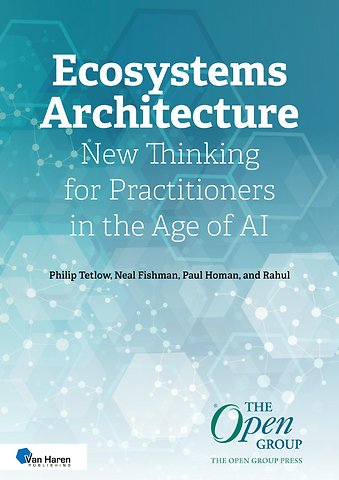Ecosystems Architecture
New Thinking for Practitioners in the Age of AI
E-book Pdf met watermerkbeveiliging Engels 2023 1e druk 9789401811118Samenvatting
Today, modern business is adrift in a sea of connectivity and potential. Where once an organization’s IT needs could be met from within its four walls, we now see many mission-critical systems reaching out beyond an enterprise’s traditional boundaries. This is pushing solutions design well beyond the comfort zone of Enterprise Architecture and out into a world of hyper-enterprise systems.
This is a world of complexity and scale, where the changing status quo demands that organizations keep up or die. To survive, their IT systems must also evolve as the context of their environment(s) ebbs and flows. The result is a dynamic, interconnected web of critical business advantage, balanced against uncertainty and risk, and infused with AI. This is the world of Ecosystems Architecture. This book will introduce you to the challenges of designing hyper-enterprise IT systems and the tools you will need as the era of Ecosystems Architecture dawns. It explains the proximity of new thinking to long-held architectural tenets and outlines how and why thinking has moved on. It also reviews existing frameworks and explains how and why they fit into the broader landscape of architectural thinking.
About The Open Group Press
The Open Group Press is an imprint of The Open Group for advancing knowledge of information technology by publishing works from individual authors within The Open Group membership that are relevant to advancing The Open Group mission of Boundaryless Information Flow™. The key focus of The Open Group Press is to publish high-quality monographs, as well as introductory technology books intended for the general public, and act as a complement to The Open Group Standards, Guides, and White Papers. The views and opinions expressed in this book are those of the authors, and do not necessarily reflect the consensus position of The Open Group members or staff.
Trefwoorden
Specificaties
Lezersrecensies
Inhoudsopgave
The Open Group Press vii
The Open Group vii
About the Authors viii
Contributors ix
Trademarks x
Acknowledgements xi
Foreword xii
Prologue xiv
History and Background xiv
1. From Enterprise to Ecosystem 1
1.1. Scale, Structure, and Human-Centric Purpose 4
1.2. Sociotechnical Systems 6
1.3. Within a Hairsbreadth of Enterprise? 7
1.4. Attributes and Components, then up through Systems and Enterprises, Followed by Nodes 8
1.5. Emergent Structure, Taoist Thinking, and Abstract Workspaces 9
1.6. Natural Successors 10
2. What is all the Fuss About? 12
2.1. Evolution Over Change in IT Systems (Universal Darwinism) 12
2.2. Things We Know About Complexity and Scale in Sociotechnical Ecosystems 14
2.3. Commerce and Ecosystems 16
2.4. Minimum Effort in Organization and Structure 16
2.5. How and Why Ecosystems Form 17
2.6. Business Response and Beyond 18
2.7. Revelation Not Revolution, and on to Emergent Intelligence 19
2.8. Pseudo Ecosystems and the Restricted Use of Collaboration Tools 21
2.9. Autocatalism and the Extremes of Complex Systems 22
2.10. Back Down to Earth 24
3. Tooling From First Principles — None of This is New 27
3.1. Model Driven Architecture 29
3.2. Toward an Ecosystems Framework 30
3.3. Graph Theory and Graphs 31
3.4. Graphs, Architectural Schematics, and Semantic Extensibility 34
3.5. Applying Measurement Systems to Graph Context 35
3.6. Continuous Cartesian Spaces 38
3.7. Vectors 39
3.8. Graph Node Comparison Using Vectors and Trigonometry 40
3.9. Cosine Similarity 43
3.10. Bringing This All Together 43
3.11. The Value of Vector Spaces in Modeling Ecosystems 45
3.12. Asset Approximation Using Vector Proximity 46
3.13. Star Gazing and the Search for Black Holes 47
3.14. GenAI 50
3.15. What Does this Mean for Architectural Practice and Tooling? 52
3.16. Limitations and Inference 56
3.17. GenAI Patterns for Ecosystems Architecture 57
3.18. So What? 59
4. That is All Well and Good — Coping Mechanisms. 62
4.1. Prior Art 62
4.2. Software Lifecyle Approaches 65
4.3. The VIE Framework 66
4.4. The Seeds of a Hyper-Enterprise New Method 67
4.5. Cells 67
4.6. From VIE to VIPER 69
4.7. The 7+1 Keys of Viable Enterprise Ecosystems 71
4.8. End Thoughts 72
5. Existing Ecosystems Thinking and Practice 73
5.1. Social Machines 73
5.2. Gaia-X 75
5.3. Semantic Web-Enabled Software Engineering 78
5.4. GenAI and Intermediate Modeling Languages 79
5.5. Quantum Semantics and Applied Quantum Computing 82
5.6. Feet Back on the Ground 86
6. Summary and Final Comments 88
Appendix A: Referenced Documents 93
Index 105
Vergelijkbare boeken
-
 Michael Youngblood€ 29,99
Michael Youngblood€ 29,99 -
 Jan Dietz€ 99,64
Jan Dietz€ 99,64 -
 LewrickDesign Thinking for Business Growth: How to Design and Scale Business Models and Business Ecosystems€ 38,15
LewrickDesign Thinking for Business Growth: How to Design and Scale Business Models and Business Ecosystems€ 38,15 -
 Svyatoslav Kotusev€ 86,85
Svyatoslav Kotusev€ 86,85 -
 Andrew Josey€ 21,26
Andrew Josey€ 21,26 -
 Tendayi Viki€ 49,95
Tendayi Viki€ 49,95
Anderen die dit e-book kochten, kochten ook
Rubrieken
- advisering
- algemeen management
- coaching en trainen
- communicatie en media
- economie
- financieel management
- inkoop en logistiek
- internet en social media
- it-management / ict
- juridisch
- leiderschap
- marketing
- mens en maatschappij
- non-profit
- ondernemen
- organisatiekunde
- personal finance
- personeelsmanagement
- persoonlijke effectiviteit
- projectmanagement
- psychologie
- reclame en verkoop
- strategisch management
- verandermanagement
- werk en loopbaan















